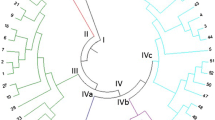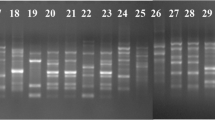Abstract
Fusarium oxysporum f. sp citri is a new soil-borne pathogen of mature citrus trees in Tunisia. ISSR and RAPD markers were used in this study to characterize strains of Fusarium oxysporum from citrus in Tunisia. Pathogenicity assays revealed that Fusarium oxysporum isolates caused from 32 to 95 % disease on seedlings of Citrus aurantium. Results showed that pathogenic isolates were classified into two groups on the basis of ISSR and RAPD fingerprints, suggesting a level of genetic specificity and diversity not previously identified on Fusarium oxysporum f. sp citri. Cluster analysis, principal coordinate analysis and population structure indicated that the different isolates appears to be related only to the host. Potential primers related to ISSR markers could be selected to characterize Tunisian strains of Fusarium oxysporum and determine genetic differences of the pathogen virulence. With this investigation we characterize Fusarium wilt on citrus trees by the mean of ISSR and RAPD markers.




Similar content being viewed by others
References
Assigbetse, K. B., Fernandez, D., Doubios, M. P., & Geiger, J. P. (1994). Differentiation of Fusarium oxysporum f. sp. vasinfectum races on cotton by random amplified polymorphic DNA (RAPD) analysis. Phytopathology, 84, 622–626.
Bayraktar, H., & Dolar, F. S. (2008). Genetic diversity of wilt and root rot pathogens of chickpea. Turkish Journal of Agriculture., 33, 1–10.
Bayraktar, H., Dolar, F. S., & Maden, S. (2007). Use of RAPD and ISSR markers in detection of genetic variation and population structure among Fusarium oxysporum f. sp. ciceris isolates on chickpea in Turkey. Journal of Phytopathology, 156, 146–154.
Baysal, Ö., Siragusa, M., Ikten, H., Polat, I., Gumrukcu, E., Yigit, F., Carimi, F., & Da Silva, J. A. T. (2009). Fusarium oxysporum f. sp. lycopersici races and their genetic discrimination by molecular markers in West Mediterranean region of Turkey. Physiological and Molecular Plant Pathology, 74, 68–75.
Baysal, Ö., Siragusa, M., Gumrukcu, E., Zengin, S., Carimi, F., Sajeva, M., & Da Silva, J. A. T. (2010). Molecular characterization of Fusarium oxysporum f. melongenae by ISSR and RAPD markers on eggplant. Biochemical Genetics, 48, 524–37.
Baysal, Ö., Karaaslan, Ç., Siragusa, M., Alessandro, R., Carimi, F., De Pasquale, F., & Da Silva, J. A. T. (2013). Molecular markers reflect differentiation of Fusarium oxysporum forma speciales on tomato and forma on eggplant. Biochemical Systematics and Ecology, 47, 139–147.
Booth, C. (1971). The genus Fusarium (p. 237). Kew: Commonwealth Mycological Institute.
Bornet, B., & Branchard, M. (2001). Nonanchored inter sequence repeat (ISSR) markers: reproducible and specific tools for genome fingerprinting. Plant Molecular Biology Reporter, 19, 209–215.
Chiocchetti, A., Ghignone, S., Minuto, A., Gullino, M. L., Garibaldi, A., & Migheli, Q. (1999). Identification of Fusarium oxysporum f. sp. basilici isolated from soil, basil seed, and plants by RAPD analysis. Plant Disease, 83, 576–581.
Do Amaral, D. O. J., de Almeida, C. M. A., Malafaia, C. B., da Silva, M. L. R. B., Correia, M. T. S., Lima, V. L. M., & da Silva, M. V. (2013). Identification of races 1, 2 and 3 of Fusarium oxysporum f. sp. lycopersici by molecular markers. African Journal of Microbiology Research, 7, 2324–2331.
Dubey, S. C., & Singh, S. R. (2008). Virulence analysis and oligonucleotide fingerprinting to detect diversity among Indian isolates of Fusarium oxysporum f. sp. ciceris causing chickpea wilt. Mycopathologia, 165, 389–406.
Dufresne, F., Markova, S., Vergilino, R., Ventura, M., & Kotlı’k, P. (2011). Diversity in the reproductive modes of European daphnia pulicaria deviates from the geographical parthenogenesis. PLoS ONE, 6(5), e20049. doi:10.1371/journal.pone.0020049.
Gordon, T. R., & Martyn, R. D. (1997). The evolutionary biology of Fusarium oxysporum. The Annual Review of Phytopathology., 35, 111–128.
Grajal-Martin, M. J., Simon, C. J., & Muehlbauer, F. J. (1993). Use of random amplified polymorphic DNA (RAPD) to characterize race 2 of Fusarium oxysporum f. sp. pisi. Phytopathology, 83, 612–614.
Haji-Allahverdipoor, K., Bahramnejad, B., & Amini, J. (2011). Selection of molecular markers associated with resistance to Fusarium wilt disease in chickpea (Cicer arietinum L.) using multivariate statistical techniques. Australian Journal of Crop Science, 5, 1801–1809.
Hannachi, I., Rezgui, S., & Cherif, M. (2014). First report of mature citrus trees being affected by Fusarium wilt in Tunisia. Plant Disease, 98(4), 566–566.
Jimenez-Diaz, M. M., Perez-Artes, E., & Jimenez-Diaz, R. M. (2001). Identification of pathogenic races 0, 1B/C, 5 and 6 of Fusarium oxysporum f. sp. ciceris with random amplified polymorphic DNA (RAPD). European Journal of Plant Pathology, 107, 237–248.
Jimenez-Gasco, M. M., & Jimenez-Diaz, R. M. (2003). Development of a specific polymerase chain reaction-based assay for the identification of Fusarium oxysporum f. sp. ciceris and its pathogenic races 0, 1A, 5 and 6. Phytopathology, 93, 200–209.
Jimenez-Gasco, M. M., Milgroom, M. G., & Jiménez-Díaz, R. M. (2002). Gene genealogies support Fusarium oxysporum f. sp. ciceris as a monophyletic group. Plant Pathology, 51, 72–7.
Kelly, A. G., Alcala-Jiménez, A. R., Bainbridge, B. W., Heale, J. B., Pérez-Artés, E., & Jiménez-Dıaz, R. M. (1994). Use of genetic fingerprinting and Random Amplified Polymorphic DNA to characterize pathotypes of Fusarium oxysporum f. sp. ciceris infecting chickpea. Phytopathology, 84, 1293–1298.
Kistler, H. C. (1997). Genetic diversity in the plant-pathogenic fungus Fusarium oxysporum. Phytopathology, 87, 474–479.
Kroes, J. M. L. W., Sommers, E., & Lange, W. (1998). Two in vitro assays to evaluate resistance in Linum usitatissimum to Fusarium wilt disease. European Journal of Plant Pathology, 4, 725–736.
Leivens, B., Rep, M., & Thomas, B. P. (2008). Mini—review recent developments in the molecular discrimination of formae speciales of Fusarium oxysporum. Pest Management Science, 64, 781–788.
Leslie, J. F., & Summerell, B. A. (2006). The Fusarium laboratory manual (1st ed.). Ames: Blackwell Publishing.
Meyer, W., Lieckfeldt, E., Kuhls, K., Freedman, E. Z., Borner, T., & Mitchell, T. G. (1993). DNA- and PCR-fingerprinting in fungi. In S. D. J. Pena, R. Chakraborty, J. T. Epplen, & A. J. Jeffreys (Eds.), DNA fingerprinting: State of the science (pp. 311–320). Basel: Birkh/iuser Verlag.
Michielse, C. B., & Rep, M. (2009). Pathogen profile update: Fusarium oxysporum. Molecular Plant Pathology, 10, 311–324.
Migheli, Q., Briatore, E., & Garibaldi, A. (1998). Use of random amplified polymorphic DNA (RAPD) to identify races 1, 2, 3 and 8 of Fusarium oxysporum f. sp. dianthi in Italy. European Journal of Plant Pathology, 104, 49–57.
Mishra, R. K., Pandey, B. K., Singh, V., Mathew, A. J., Pathak, N., & Zeeshan, M. (2013). Molecular detection and genotyping of Fusarium oxysporum f. sp. Psidii isolates from different agro-ecological regions of India. Journal of Microbiology, 51, 405–412.
Möller, E. M., Bahnweg, G., Sanderman, H., & Geiger, H. H. (1992). A simple and efficient protocol of isolation of high molecular weight DNA from filamentous fungi fruit bodies, and infected plant tissue. Nucleic Acids Research, 20, 6115–6116.
Nei, M. (1987). Molecular evolutionary genetics (p. 512). New York: Columbia University Press.
Raymond, M., & Rousset, F. (1995). GENEPOP Version 1.2: population genetics software for exact tests and ecumenicism. Journal of Heredity, 86, 248–249.
Rohlf, F. J. (2000). NTSYS-pc numerical taxonomy and multivariate analysis system. Version 2.1. Setauket: Exeter Publications.
Rosewich, U. L., Pettway, R. E., McDonald, B. A., & Kistler, H. C. (1999). High levels of gene flow and heterozygote exces characterize Rhizoctonia solani AG-1 IA (Thanatephorus cumumeris) from texas. Fungal Genetcis and Biology., 28, 148–159.
Schmale, D. G., Leslie, J. F., Zeller, K. A., Saleh, A. A., Shields, E. J., & Bergstrom, G. C. (2006). Genetic structure of atmospheric populations of Gibberella zeae. Phytopathology, 96, 1021–1026.
Spina, S., Coco, V., Gentile, A., Catara, A., & Cirvilleri, G. (2008). Association of Fusarium solani with ROLABC and wild type troyer citrange. Journal of Plant Pathology, 90(3), 479–486.
Tantaoui, A., Ouinten, M., Geiger, J. P., & Fernandez, D. (1996). Characterization of a single clonal lineage of Fusarium oxysporum f. sp. Albedinis causing bayoud disease of date palm in Morocco. Phytopathology, 86, 787–792.
Thangavelu, R., Kumar, K. M., Ganga Devi, P., & Mustaffa, M. M. (2012). Genetic diversity of Fusarium oxysporum f.sp. cubense isolates (Foc) of India by Inter Simple Sequence Repeats (ISSR) Analysis. Molecular Biotechnology, 51, 203–211.
Timmer, L. W., Garnsey, S. M., Grimm, G. R., El-Gholl, N. E., & Schoulties, C. L. (1979). Wilt and dieback of Mexican lime caused by Fusarium oxysporum. Phytopathology, 69, 730–734.
Van Putten, W. F., Biere, A., & Van Damme, J. M. M. (2003). Intraspecific competition and mating between fungal strains of the anther smut Microbotryum violaceum from the host plants Silene latifolia and S. dioica. Evolution, 57, 766–776.
Welsh, J., & McClelland, M. (1990). Fingerprinting genomes using PCR with arbitrary primers. Nucleic Acids Research, 18, 7213–7218.
Williams, J. G. K., Kubelik, A. R., Livak, K. J., Rafalski, J. A., & Tingey, S. V. (1990). DNA polymorphisms amplified by arbitrary primers are useful as genetic markers. Nucleic Acids Research, 18, 6531–6535.
Acknowledgments
The financial assistance provided by the Department of Science and Technology (DST) and Ministry of External Affairs (MEA), Government of India through the Federation of Indian Chambers of Commerce and Industry (FICCI), has launched the CV Raman Iternational Fellowship programme, Project Director of Derectorate Oilseed Research (DOR) Rajendranagar, Hyderabad. The authors are highly grateful and obliged to Dr D. Kumar, Biotechnology Lab, DOR and thanks Mr. J. Ramyya for the technical guidance.
Author information
Authors and Affiliations
Corresponding author
Rights and permissions
About this article
Cite this article
Hannachi, I., Poli, A., Rezgui, S. et al. Genetic and phenotypic differences of Fusarium oxysporum f. sp. citri isolated from sweet orange and tangerine. Eur J Plant Pathol 142, 269–280 (2015). https://doi.org/10.1007/s10658-015-0611-1
Accepted:
Published:
Issue Date:
DOI: https://doi.org/10.1007/s10658-015-0611-1




